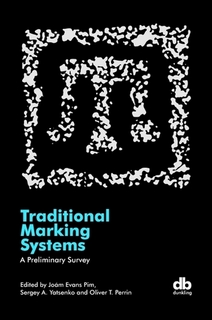Signum announces the 2010 publication of Traditional Marking Systems.
Joám Evans Pim, Sergey A. Yatsenko, Oliver T. Perrin (Eds.), Traditional Marking Systems: A Preliminary Survey. Dunkling Books, London & Dover, 2010, 518 pp, ISBN 978-0-9563478-1-7 (paperback)
Marks are everywhere. On boundary stones they delineate borders and proclaim property ownership. In the form of seals they communicate identity and state authority. Hallmarks and trademarks denote quality and origin. Heraldic devices are used for military organization and to indicate family and clan affiliation. Corporate brand insignia are intended to evoke emotional and experiential associations to stimulate transactions. Currency symbols embody conceptual bases for categorical distinction in integrated systems of valuation.
With the publication of Traditional Marking Systems, specialists in mark studies have taken a significant step forward. This collection of 26 essays by leading researchers in the field of marks studies, and an introduction by the editors, sheds new light on the temporal depth and geographic breadth of the use of non-linguistic marks by humans.
As noted by the editors in the introduction
“[T]his is probably the first time marks are considered globally, covering their occurrence from China to South America, from India to Northern Europe, from the Mediterranean to Western Africa. Of course not all occurrences are explored but this approach definitely expands the conception of marks as a purely local or regional phenomenon which characterized many of the earlier works. The wide range covered by the featured chapters facilitates the emergence of a cross-cultural interdisciplinary approach to the study of marks that will hopefully follow in the years to come.”
The volume includes the following studies:
• Oliver T. Perrin, Joám Evans Pim, Sergey A. Yatsenko: Mark Studies: An Interdisciplinary Approach
• Oliver T. Perrin: Tamgas and Space. Territorial Mark and Mnemotechnic
• Imre Gráfik: Property Sign Examination Through Entropy Analysis
• Etienne Landais: The Marking of Livestock in Traditional Pastoral Societies
• Sergey A. Yatsenko: Problems and Study Methods of the Ancient and Early Medieval Iranian-Speaking Peoples’ Nishan-Signs
• Sergey A. Yatsenko: Marks of the Ancient and Early Medieval Iranian-Speaking Peoples of Iran, Eastern Europe, Transoxiana and South Siberia
• John Boardman: Seals and Signs, Anatolian Stamp Seals of the Persian Period Revisited
• Jean-Pierre Digard: Forms and Functions of Livestock Branding Among the Nomads of Iran
• Murtazali S. Gadjiev: On the Interpretation of Derbent’s Mason Marks
• Jangar Ilyasov: Nomad Heritage, Kushan Tamga-Signs from Southern Uzbekistan
• Catherine Baroin: Livestock Property Marks In Africa
• Chandreyi Basu: Tilaka, Traditional Body Markings in India
• Alexey V. Chernetsov: Russian Traditional Property Signs
• Caroline Humphrey: Horse Brands of the Mongolians
• Zainolla S. Samashev and Napil Bazylkhan: Ancient Turkic Tamga-Signs
• Samat Samashev: Kazakh Tamgas
• Takashi Osawa: On Functional Changes of Tamga and Nishan-signs in the Old Turkic Period
• Mehmet Tezcan: Tamgas among the Turks in the Middle Ages
• Gaybulla Babayarov: The Tamgas of the Co-Ruling Ashina and Ashida Dynasties as Royal Tamgas of the Turkic Kaghanate
• Osman Mert: Petroglyphs and Tamgas in the vicinity of Gurvan Mandal
• Sinclair Hood: Mason’s Marks in the Palaces
• Boris N. Morozov and Rem A. Simonov: Finno-Ugrian Permian Pas-Signs
• Anton C. Zeven: Illustrated Examples of European Marks
• Tuve Skånberg: Christian Identity Marks and their influence on European ‘Merchants’ Marks’
• Domenico Isabella: Ownership Marks in the Oriental Alps
• Joám Evans Pim: Indigenous and European Marking Systems in Brazil
• Paul Harthoorn: Computerization of European Personal Marks
